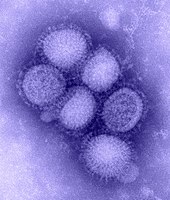
Photo from wikipedia
Vaccines remain the best measure to reduce total influenza burden. However, presently available influenza vaccines have some limitations that cause a reduced efficacy compared to immunization practices with other respiratory… Click to show full abstract
Vaccines remain the best measure to reduce total influenza burden. However, presently available influenza vaccines have some limitations that cause a reduced efficacy compared to immunization practices with other respiratory pathogens. This paper shows the clinical roles of antiviral drugs against influenza that have been licensed in at least one country and the potential roles of compounds that are in development. Several attempts have been made to develop new agents against influenza viruses to overcome the supposed or demonstrated limitations of neuraminidase inhibitors (NAIs). Antibodies against the highly conserved stem region of the haemagglutinin molecule of influenza A viruses and drugs that target different stages of the influenza virus life cycle than NAIs in human cells have been developed and tested. Among these preparations, baloxavir marboxil (BAM), and favipiravir (FP) (i.e., polymerase inhibitors) are the only drugs that have reached the market (the first in Japan and the USA, and the second only in Japan). Other antiviral compounds and monoclonal antibodies are in advanced stage of development, but none of these new drugs and monoclonal antibodies in development have adequate characteristics to substitute for NAIs at present. However, although NAIs remain the drug of choice for influenza treatment, their overuse has to be avoided. Accurate selection of patients for whom treatment is truly needed is required.
Journal Title: Frontiers in Medicine
Year Published: 2019
Link to full text (if available)
Share on Social Media: Sign Up to like & get
recommendations!